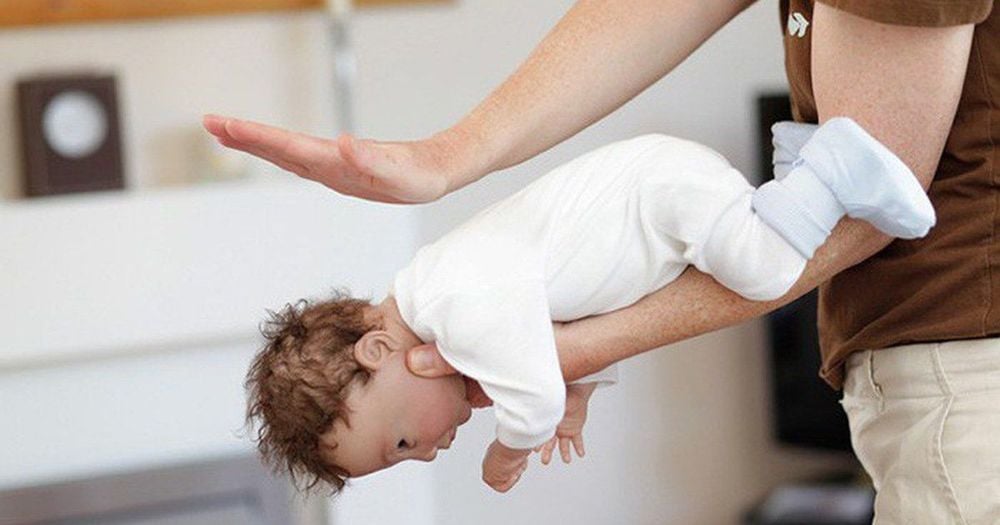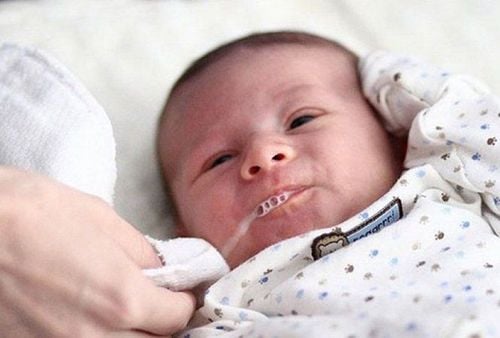This is an automatically translated article.
The article was professionally consulted by Specialist Doctor II Le Thanh Cam - Department of Pediatrics - Neonatology - Vinmec Danang International General Hospital. Uncle has 15 years of experience in diagnosis & treatment of pediatric diseases; She used to work at the Pediatric Department - Da Nang Hospital and Da Nang Center for Obstetrics and Gynecology. His strength is in the diagnosis and treatment of pediatric pathologies, resuscitation, pediatric emergency.Choking milk is a common phenomenon in infants. When an infant chokes on milk, if the mother does not know how to handle it, the milk can enter the airway, causing the child to stop breathing, convulsing, turning pale, if the child is not given first aid in time, it can be life-threatening. . Therefore, parents need to know how to prevent choking on milk.
1. Why do babies often choke on milk?
Choking on milk is a very common accident in Pediatrics, even in advanced countries. British, French, and American documents have recorded many cases of babies under 12 months old being found dead in a crib or bed after breastfeeding or after a meal, focusing more on days that are too hot or too cold.
There are many causes of choking in babies as follows:
Because the mother breastfeeds the baby in the wrong position, forcing the baby to suck when the baby is crying, coughing or laughing. The correct posture is to hold the child with his head high, in a comfortable position. In case the mother breastfeeds the baby in a state of flexed or tilted neck, it will make the baby very easy to choke. Parents should also note, if the baby is crying, do not be too impatient but quickly press the nipple into the baby's mouth, this action will cause the baby to choke on milk immediately. Because the perforated pacifier is too large, the milk flows quickly, making it difficult for the baby to swallow. Some mothers breastfeed their babies while the baby is dreaming, that is, while the baby's body has begun to gradually go to sleep. At this time, breast milk is still flowing but the baby does not swallow it, but only holds it in the mouth. When breathing rapidly, babies can inhale milk brought up the nose into the trachea, bronchi and cause choking. Due to too much breast milk, the milk overflows with a large flow, making it difficult for the baby to swallow. Hungry children should suckle milk in a hurry, then they may cough or laugh suddenly, causing them to choke. Children 3-4 months old have begun to know how to talk, pay attention to people around. If the mother is talking and playing with the baby while breastfeeding, it may cause the baby to choke on milk. In the case of bottle-feeding, but the nipple is far away, the baby's mouth is not closed, and the slope of the bottle is not high enough. As a result, the baby swallows a lot of air when feeding, leading to bloating and vomiting after feeding. Forcing the baby to suck too much, leading to spitting up milk. Sometimes parents squeeze the nose to let the child open his mouth to pour milk and powder in, causing the child to choke.

Place the baby to lie down immediately after feeding. Do not monitor children regularly after feeding (there are many cases of children dying from choking milk without parents knowing). Choking occurs frequently and mainly in newborn babies, because the stomach of the baby is still horizontal, the angle between the stomach and the esophagus is an obtuse angle that has not formed a sphincter to play a role in preventing reflux when distended stomach. When choking, the milk will overflow, causing irritation to the nose and at the same time the nose will be sore, making the baby uncomfortable and fussy. When the child chokes, milk enters the respiratory tract, causing suffocation, leading to death or to dangerous sequelae such as brain damage (hemorrhage, brain death...), cardiac arrest, pneumonia (due to inhaling food, because intestinal parasites are brought to the lungs)...
Trắc nghiệm: Sự phát triển tinh thần, vận động của bé thế nào là đúng chuẩn?
Khi nào bé biết nói, biết hóng chuyện hay biết cầm cốc là "đúng chuẩn"? Điểm xem bạn biết được bao nhiêu mốc phát triển tinh thần, vận động "đúng chuẩn" của bé nhé!The following content is prepared under supervision of Thạc sĩ, Bác sĩ y khoa, Ma Văn Thấm , Nhi , Phòng khám Đa khoa Quốc tế Vinmec Dương Đông(Phú Quốc)
2. How to handle choking milk in babies
When a newborn baby chokes on milk, as soon as they find out about their baby's condition, parents need to handle choking milk according to the instructions below:
Use the mouth to clear the airway:
The mother quickly sucks with her mouth. force to suck all the milk in the nose, the baby's mouth out as quickly as possible. Suction mouth first, nose after. If delayed, milk enters the trachea causing airway obstruction, causing the baby to stop breathing. Back patting, chest compressions:
One hand supports the child's chest, the other palm strongly pats the child's back 5 times, the position is between the shoulder blades (slap with just enough force, do not slap too hard on the child's body. ) to increase the pressure in the chest to help the milk flow out. If the child still finds it difficult to breathe, pale, parents should have the child lie on his back on the bed, table, floor, ... use the index finger and middle finger to suddenly press a moderate force down the lower half of the child's sternum, repeat. 5-10 times until the baby can breathe normally, the choking stops. For children with symptoms of apnea, it is possible to combine the above two measures at the same time and give rescue breaths so that the child can breathe again. After giving first aid, please pat the child's bottom or thigh to stimulate the child to wake up, let the baby cry and breathe, then urgently take the child to the nearest hospital or medical facility for treatment. Do not take the child away when the child cannot breathe, because the brain without oxygen for a few minutes will not be able to recover.

3. Prevent choking on milk for children
Feed in the head-up position, or place the baby in a semi-recumbent chair. Avoid letting the child lie with his or her head upright. If the baby has a stuffy nose, the sputum must be removed from the nose and mouth before feeding. Elevate the bottle to avoid air stagnation in the bottle. For children with upper respiratory tract infection, must breastfeed slowly (do not punch too large holes in the nipple), if the baby cannot swallow milk in time, it must be stopped immediately. After feeding, hold the baby upright for at least 15 minutes and pat his back to burp. Do not let the child lie on his or her stomach or face the wall. Parents regularly monitor their children's sleep. Do not let the child lie in an environment that is too hot or too cold to avoid breathing disturbances. If your baby has severe heart disease or pneumonia, ask your doctor about breastfeeding. Limit breastfeeding while sleeping. Let your baby sleep enough, when he wakes up, feed him milk. When breastfeeding, you should not laugh with the baby, this will make the baby laugh, leading to choking on milk. With the above knowledge, parents must have gained a lot of knowledge about the phenomenon of choking milk in babies and at the same time remember the ways to prevent babies from choking, helping mothers have more experience in caring for babies. take care of your baby.
In order to avoid choking on milk or vomiting in young children, parents should provide reasonable zinc for their children, along with other important vitamins and minerals such as lysine, chromium, B vitamins,... Substances This nutrition will help your child eat well, have a good immune system, strengthen the resistance to get sick less often and have less digestive problems.
Please dial HOTLINE for more information or register for an appointment HERE. Download MyVinmec app to make appointments faster and to manage your bookings easily.















